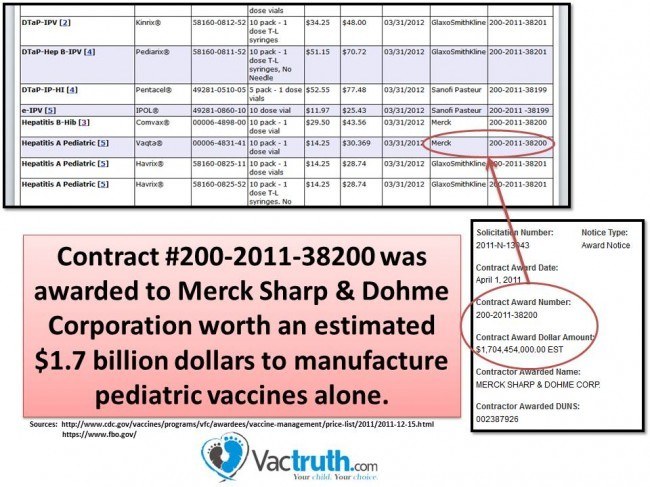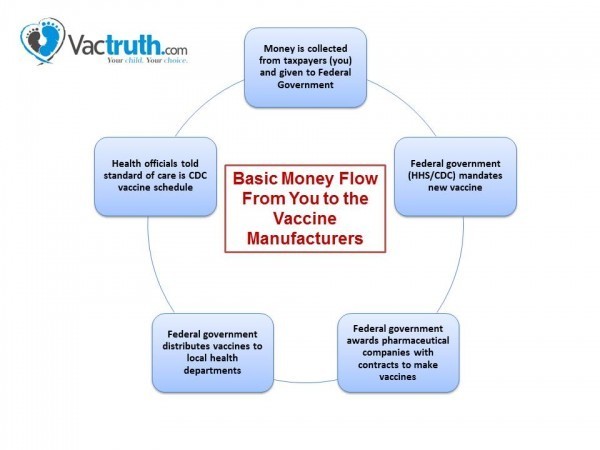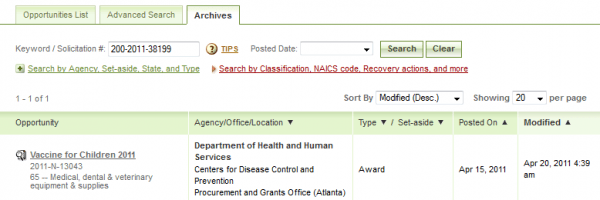
In 2011, the US Federal government awarded 6 pharmaceutical corporations over 5.7 Billion to manufacture children’s vaccines alone.
According to information on the Centers for Disease Control and Federal Business Opportunities websites, the contracts were for the federal Vaccines for Children (VFC) program. [1,2]
The VFC program purchases the vaccines from the vaccine manufacturer. The vaccines are then distributed to state health departments and territorial public health agencies. In turn, children who couldn’t normally afford vaccines are supposed be injected at no cost. [3]
Many vaccine supporters use examples like the VFC program as indisputable proof of kindness on the part of the government and pharmaceutical companies. I think most parents have heard how generous, caring, and loving they are, haven’t you?
I’d like for you to consider an alternative motive when looking at the contract amounts: a corporate agenda.
Before we get into the individual contract numbers and the corporations who received the money, I’d like to take a moment and share these 4 facts with you:
- Pharmaceutical companies care about profits and shareholders, not your children.[4]
- Since 1989, pharmaceutical companies have paid only 2.3 billion dollars for vaccine injuries. Given the total lifetime care of a vaccine-injured child, many parents believe this figure should be substantially higher.[5]
- The National Childhood Vaccine Injury Act of 1986 (Public Law 99-660) created the National Vaccine Injury Compensation Program (VICP). Vaccine manufacturers (and doctors!) are given complete immunity from any legal liability if your child is harmed by their vaccine(s). No other industry enjoys this level of protection from a product that could injure a child! [6]
- Some of the same pharmaceutical companies listed below have been charged with criminal acts by the Department of Justice.[7]
Contracts and Following the Money
As much as we like to believe we can get something for nothing from Uncle Sam, it’s just not true. There is no such thing as a free lunch. It is simple cause and effect.
While we may never have an opportunity to see into pharma’s accounting books, it is an important step in following the money and seeing who benefits. Here is the contract information I promised earlier in the article.
Company |
Contract |
Amount |
| Sanofi Pasteur | 200-2011-38199 | $1,142,400,000.00 [10] |
| GlaxoSmithKline | 200-2011-38201 | $786,456,400.00 [11] |
| Merck | 200-2011-38200 | $1,704,454,000.00 [12] |
| Novartis | 200-2011-38204 | $451,660,000.00 [13] |
| Pfizer | 200-2011-38203 | $1,652,570,000.00 [14] |
| MassBiologics | 200-2011-38202 | $11,250,000.00 [15] |
Total |
$5,748,790,400.00 |
Are we sure there isn’t some type of corporate agenda?
Read on.
But Vaccine Companies Don’t Make That Much Money, Do They?
It’s a good question to keep asking – and I don’t think it will be solved here.
We may never know the exact amount they profit from vaccines, yet looking into contract amounts is an important step in following the money and seeing who benefits. Look at this important information.
Overall Cost
For example, the World Health Organization website discusses what factors go into establishing vaccine prices. One of the more repeated points you see is:
“Vaccine production costs have a significant fixed cost component, reaching up to 90 percent of total costs. These costs include research and development (R&D), quality control and quality assurance, selling and distribution overhead, and the construction and maintenance of production facilities.” [16]
Let’s assume nothing changes over time – such as increased efficiency in research and development, manufacturing, vaccine tax, etc. – the remaining 10 percent is profit for the pharmaceutical companies.
If we estimate a 10 percent profit from 5.7 billion dollars, this leaves the corporations with an average of 100 million dollars per company.
I have to ask you this question, “Is $100,000,000 a lot of money to you?”
Keep in mind, this is only for the federal Vaccines For Children (VFC) program. The total amount is likely much higher.
Also, do you remember Public Law 99-660 mentioned above? No corporation, corporate executive, board member, doctor, state or local health official can be held responsible for a vaccine injuring your child. Thus, Big Pharma’s profits from manufacturing vaccines are very safe.
Well played, Big Pharma.
Here’s the Bottom Line: Pharma Gets a Free Meal Ticket
What is really happening is the US Federal government has given the corporations a guaranteed paycheck through the contracts. It makes perfect sense why the federal health agencies would keep demanding more vaccinations – they get more money!
Take the example of the former head of the Centers for Disease Control (CDC), Julie Gerberding. She helped promote the highly controversial Gardasil vaccine while she served in her government post. After she finished working for the CDC, she was made President of the Vaccine Division for Merck Pharmaceuticals.
To illustrate my point, I created a simple summary of one way money pours into the pharmaceutical company’s coffers.
When government money is given to corporations, we have to start looking at the individual humans who serve them.
Here’s one perspective from a legendary American trial lawyer, Gerry Spence, as he describes corporations as:
“… not a human being. It is not a group of human beings. Remember that. It is a fictional structure. A form – a nonliving, nonbreathing, nonhuman form – an invisible form…I have heard many a corporate executive argue that he has no loyalty to his employees, to his customers, or to his country. His loyalty, all of it, is to the profit of his shareholders.” [8,9]
Indeed, the love of money (greed) is a very common human attribute and becomes a problem as in the case of pharmaceutical giant Pfizer.
They were charged by the Department of Justice with payments to influence government officials. In turn, Pfizer was ‘fined’ 40 million dollars.
Put in context, it is about 2.5 percent of the grant money given to them by the CDC for making vaccines. [7] It’s a pity that laws passed by the same politicians are not overturned when this type of tomfoolery is uncovered.
But that game is well-understood by Pharma, is it not?
Conclusion
If your child is harmed by vaccines, you should know your hands are legally tied.
Through public law, these corporations have been made too big to fail, just like the banks. They make a hefty profit from government contracts. It’s a guaranteed paycheck for them – there is no incentive to change the process.
We must remember the pharmaceutical companies are in business to make profits and ensure shareholder value. I recently shared a graphic on the VacTruth.com Facebook page which sums up how I feel, “The pharmaceutical industry does not create cures, they create customers.”
[contentbox headline=”Tip for Readers” type=”download”]
If you want to look up the award amounts for yourself, follow these 3 easy steps.
- Go to https://www.fbo.gov/index?s=opportunity&mode=list&tab=archives
- Copy and Paste one of the contract numbers listed above (Ex. “200-2011-38199”) into the “Keyword / Solicitation #” field.
- In the “Posted Date” field, make sure the ‘blank’ value is selected. It is above the “Today”. You should get a result similar to what is below (click on the image to enlarge).
[contentbox headline=”References” type=”normal”]
1. http://www.cdc.gov/vaccines/pubs/acip-list.htm
3. http://www.cdc.gov/vaccines/programs/vfc/index.html
4. http://www.novartis.com/about-novartis/our-mission/index.shtml
Part of a mission statement from one pharmaceutical company states, “We also want to provide a shareholder return that reflects outstanding performance and to adequately reward those who invest ideas and work in our company.”
This language is not uncommon in corporate mission statements – even for pharmaceutical companies.
5. http://www.hrsa.gov/vaccinecompensation/statisticsreports.html#claimscompensated
6. http://www.hrsa.gov/vaccinecompensation/index.html
7. http://vactruth.com/2012/08/28/pharma-admits-to-bribes/
8. Spence, Gerry. (1995). How to Argue and Win Every Time. St. Martin’s Press. Pg 270.
9. Ilbid., Pg 281.
10. Contract Award for Sanofi Pasteur
https://www.fbo.gov/index?s=opportunity&mode=form&tab=core&id=9c6e25873f0cdaa9220b6f9a4d3f59e0
11. Contract Award for GlaxoSmithKline
12. Contract Award for Merck
13. Contract Award for Novartis
14. Contract Award for Pfizer
15. Contract Award for Mass Biologics
16. http://www.who.int/immunization_financing/options/en/briefcase_vacproduction.pdf
[/contentbox]



